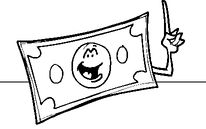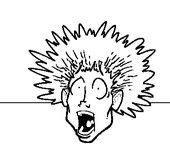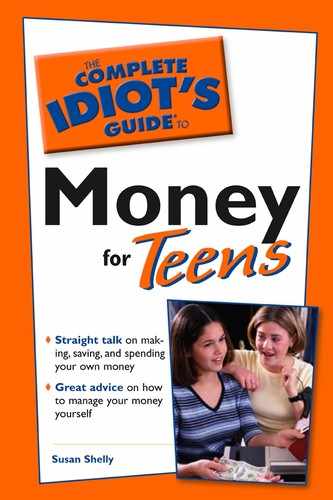
Chapter 14
ATMs and Debit Cards
In This Chapter
✧ Why banks love ATMs
✧ Understanding ATMs and debit cards
✧ Finding the best ATM
✧ Saving money on ATM fees
✧ Watching for potential pitfalls
Was there really life before automated teller machines (ATMs)? I mean, can you imagine having to actually walk into a bank, write out a withdrawal slip, wait in line, and hand the slip to a teller just to get a few dollars from your checking account?
It probably was before your lifetime, but yes, there was life before ATMs, and it was much as I just described. If you needed money, you could go to the bank and make a withdrawal from an account you had there. You could write a check at the grocery store or another location for more than the cost of your purchase and get some money back. You could borrow money from a friend or family member. However, you couldn’t swing by the ATM on your way back from swimming practice and get $20 to go out to dinner with your friends.
In this chapter, we look at the history of ATMs, how they work, and the advantages and disadvantages of these handy machines.
The History of ATMs
Automatic teller machines first showed up about 20 years ago, but they weren’t nearly as common or as popular as they are today. In fact, people were mistrustful of the machines, and banks had to run special promotions and offer gimmicks to get people to try them.

Imagine That
Customers might have been reluctant to use ATMs 20 years ago, but today the average person visits a machine 72 times a year. A category of ATM patrons known as heavy users bank at the machines an average of 156 times a year.
Of course, in time people got used to ATMs, and now they’re as common as mailboxes or phone booths. In fact, ATMs are everywhere these days. You can find them in grocery stores, restaurants, coffee shops, department stores, movie theaters, convenience stores, and gas stations—wherever you might find yourself needing some cash.
So, why were banks so anxious to push these ATMs? They’ll tell you it was to provide more convenient and better service for their customers, but we know differently, don’t we?

Money Matters
According to the Center for Responsive Law, banks today make more than $2 billion a year on ATM transactions. Not bad—for the banks, that is!
Banks love ATMs because, unlike human employees, they work 24 hours a day without complaining. And, it costs banks only about 27 cents to have a deposit or withdrawal processed at an ATM, as compared to about $1.07 for a live teller to handle the transaction.
However, the real reason banks love ATMs is that the machines generate huge amounts of money through the fees associated with them. When ATMs were first introduced, there were no fees. You could go to any machine and use its services free of charge. However, as ATMs became more accepted and popular, banks grabbed the opportunity to use them as moneymakers. Now, the majority of ATMs have fees and banks encourage their customers to use them. In fact, some banks will charge customers for making transactions with a teller inside the bank. You can’t win!
How Do ATMs Work?
To get cash from an ATM machine, you need three things:
✧ An ATM card
✧ A personal identification number (PIN)
✧ Cash in a checking or savings account in a bank or credit union that’s hooked up with the ATM system

Money Matters
If you deposit money in a bank account and try to use an ATM card soon after, your account balance is likely to come up short. That’s because your deposit hasn’t yet been credited to your account.
You can apply for an ATM card when you open an account at the bank. You might get a card immediately, or you might have to wait until it’s processed and mailed to you. Check to see if your bank, thrift, or credit union charges an annual fee for an ATM card. If it does, be sure to ask how much it will cost.
An ATM card is no good if you don’t have a PIN to go with it. Your PIN is a secret number that you need to punch into the ATM every time you conduct a transaction. You insert your card into the machine, then enter your PIN, which gives you clearance to do business. If an incorrect PIN is entered more than two or three times, the machine usually will shut down.
You can use most ATM cards to access cash from a checking or savings account, to transfer money from one account to another, and to check account balances. Some ATM machines allow you to make deposits. However, the main purpose of ATMs is to give you access to your cash.
Some ATM cards, called debit cards, also can be used to make purchases in stores, with the amount of the purchase deducted directly from your checking account. There normally is no fee for that service, and you often can get cash back above the cost of your purchase.

Scary Stuff
Be aware that, if you use an ATM machine to check account balances or transfer funds, you might end up paying a separate fee for each transaction. Ouch!
Is One ATM Better Than Another?
Yes. Some ATMs are better than others because they don’t charge a fee, or they charge a lower fee, for you to access your money. Normally, machines that your bank owns will not charge you a fee. And, there sometimes are free ATMs in convenience stores or other locations. Using a machine that belongs to a bank other than your own, or a national ATM such as Cirrus or Plus, probably will result in fees—sometimes as high as $3 per transaction.

Money Matters
It’s really important to know where the free ATMs are if your account is with a small institution or you bank online. Internet banks and some small banks and credit unions don’t have their own machines, forcing you to pay someone else for the ATM privilege if you don’t find a free machine.
Needless to say, ATMs that don’t charge you to withdraw your own money are better than those that do. Find the ones in your area that either are owned by your bank or are free, and use them whenever possible.
Advantages of ATMs and Debit Cards
The question is, why do people keep on using ATMs if they get hit up with fees all the time? I mean, you can end up spending a lot of money, just to get your money. You know the answer to that question: We use ATMs because they’re so darned convenient, and we’re willing to pay for that convenience.
ATMs are plentiful, and they’re always open. You can drive up to one in your pajamas at 3 a.m. and get money. You can get money on Veteran’s Day, New Year’s Day, or the Fourth of July—days when you’d be hard pressed to find a bank open anywhere.
Debit cards, as mentioned earlier, also can be used to your advantage. For instance, if you buy a book of stamps at a U.S. Post Office, you can use your debit card to pay for the stamps and ask the postal clerk for $20 extra. The clerk will deduct $26.60 from your checking account—$6.60 for a book of 33-cent stamps, and $20 that you’ll take in cash. You also can do this at some other places, such as grocery or drugstores. Not every place offers this service, however, so don’t assume that you’ll always be able to get extra cash.
Using your debit card to get extra cash when you need it is a smart idea, because you don’t pay fees. I shop at a grocery store where I can get up to $50 back (with no fee) when I pay for the groceries with my debit card. Or, I can pay $2.00 to use the same card in the ATM located inside the same store. That’s a no-brainer, for sure.
Getting Around ATM Fees
If you use ATMs a lot, chances are you’re going to run into some fees—at least some of the time. There are ways, however, to minimize the costs associated with these handy-dandy machines.
Let’s first figure out how much ATMs are costing us. Remember the statistic earlier that the average person uses an ATM 72 times a year? If Joe Average averages a $1 fee for each use, he’s shelling out $72 a year for the privilege of getting his own money. If he averages a $2 fee at each use, he’s up to $144 a year. At $3 a shot, Joe’s paying out $216 a year to gain access to his money.

Money Matters
The amount of money you can get back on your debit card varies from business to business. Don’t assume you’ll be able to get $30 back at your local drugstore, for instance. Its policy might be to give a maximum of only $20 back.
Now, let’s think about that heavy user. Jane has a really bad ATM habit. I mean, she’s practically a permanent fixture at her neighborhood machine. She’s there 156 times a year, and pays $2 at each visit, which means Jane pays $312 in ATM fees each year. If she averages $3 in fees every time she uses the machine, she’ll be out $468 at the end of the year. Think about what Jane could have done with the almost $500 in fees that she handed over to the bank.
Let’s look at some ways that Joe and Jane could hang on to some of their hard-earned money instead of letting the bank take it as ATM fees:
✧ Use proprietary or free machines whenever it’s possible, not just whenever it’s convenient.
✧ Don’t withdraw money in bits and pieces. If you’re going to need $50 for the coming week, withdraw $50 all at once from the ATM. This eliminates the necessity of returning to the ATM and incurring more fees.
✧ Use your debit card whenever possible to get extra cash when you make a purchase.
✧ If your own bank doesn’t have a machine that’s convenient for you to use, shop around. Don’t assume that all machines are the same—the fees vary as much as $2 per transaction.
ATMs are convenient, there’s no doubt about it, and with some planning and determination, you should be able to avoid most of the fees associated with their use. Still, there are some troublesome aspects of ATMing.

Scary Stuff
Don’t be lulled into assuming a particular ATM doesn’t have a fee because it doesn’t display a message on the screen while you’re banking. Notice of a fee might be posted as a sticker on the machine itself, and not show up on the screen.
Some Pitfalls of Plastic
It’s hard to imagine sometimes that a little plastic card can be the source of so much trouble, but, when not used properly or handled carefully, an ATM card can cause you more problems than it’s worth.
Cards get lost, stolen, or left in the machine. If any of those things happen to you, contact the card issuer immediately to report the loss. It’s also important to keep safety issues in mind as they relate to using an ATM card. ATM customers have been too-frequent targets of burglaries because thieves see them as ready sources of cash. If somebody approaches you at an ATM and demands your money, hand it over. No amount of money is worth risking injury for. If a thief demands your PIN, reveal the number, but report the theft as quickly as possible afterward.
Try to have at least one other person with you when you use an ATM, especially if it’s off by itself at the edge of a parking lot someplace. Never use an ATM by yourself at night. Once you’ve completed your transaction, move away from the ATM. Don’t stand there and count your money or balance your checkbook.
The best defense against any kind of crime, including that associated with ATMS, is to be aware of what’s going on around you at all times, and to use good common sense.
It Really Is Money
Grabbing cash from an ATM is easy and convenient. So easy and convenient, in fact, that it’s tempting to do so often. Using a debit card to pay for purchases is easy, too. For many people, using a card to pay for something doesn’t have the same effect as paying with cash does. It’s more abstract. It’s easy to convince yourself that you’re not really spending money if you don’t actually hand money over to the person on the other side of the cash register.
Trust me on this: When you use a debit card to pay for something, you’re spending money. When you use an ATM to get money from your account, you’re going to spend money. It’s really important to keep track of what you’ve got and what you’re doing with it. It’s easy to get $10 or $20 from the ATM and not think much about it, until all of the sudden you realize you’ve spent $100 and you don’t have enough left to buy a birthday present for your dad.
ATMs and debit cards have some excellent advantages, but also have the potential for heartache. Use good common sense, take advantage of no-fee or low-fee ATMs, and keep track of what you’ve got.
The Least You Need to Know
✧ Customers were reluctant to use ATMs at first, but their enthusiasm for them quickly grew.
✧ Banks are crazy about ATMs because they generate billions of dollars a year in fees.
✧ To use an ATM machine you need a card, a PIN, and money in an accessible account.
✧ Some machines are better to use than others, and there are ways to reduce the money you have to pay for ATM fees.
✧ ATMs and debit cards are convenient, but you need to keep close track of your money when using them to avoid trouble.
..................Content has been hidden....................
You can't read the all page of ebook, please click here login for view all page.
